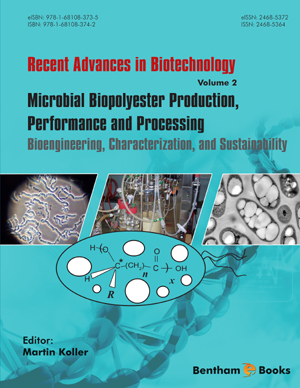Abstract
Polyhydroxyalkanoate (PHA) production cost is dependent on several factors like substrate, chosen production strain, cultivation strategy and, to a still underestimated extent, on the downstream processing needed to recover PHA from microbial biomass. The availability of green and cheap technologies for PHA recovery is crucial for the development of a reliable and sustainable PHA production chain. Inexpensive and scalable recovery schemes need to be devised to achieve low-cost production that is competitive with traditional thermoplastics. Hence, in order to maximize both biomass growth and PHA productivity, one has to carefully optimize the operation conditions; this aspect of bioprocesses is of major economic importance in a bioprocess. PHA, a group of biobased microbial biopolyesters subjectable towards biodegradation constitute promising candidates to potentially substitute diverse conventional petrol-based plastics. As a drawback, PHA´s too high production cost still hampers their success on the on the market. The most prominent cost generating factors are the upstream processing, the bioprocess (fermentation), and, last, but not least, thus downstream processing dedicated to PHA recovery from microbial biomass. Downstream processing severely accounts to the economics of the overall process. A broad range of diverse recovery techniques can be found in the literature, most of them studied exclusively on small bench scale, with some exceptions which performed well also during industrial operation. Recovery by solvent extraction, chemical or enzymatic digestion of non-PHA cellular material, mechanical disintegration of cells, supercritical fluid extraction, flotation techniques, gamma irradiation and, more recently, the use of aqueous two-phase systems are reported. The present chapter summarizes investigated recovery methods and compares them in terms of efficacy and resulting product quality (e.g., purity and impact on molar mass).
Keywords: Acetone, Aqueous two phase systems (ATPS), Characterization, Chemical digestion, Downstream processing, Enzymatic digestion, Mechanical disruption, PHA non-solvents, PHA recovery methods, Polyhydroxyalkanoates (PHA), Poly(3-hydroxybutyrate-co-3-hydroxyvalerate-co-4-hydroxybutyrate) (PHBHV4HB), Purification, Solvent extraction, Supercritical fluids (scF).






















